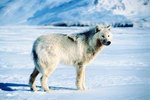
Coyotes howl, bark and yip for the same reason humans speak: They have something they want to say to other members of their species. People who have studied coyote communication don't understand all its subtleties -- they marvel at its sophistication. Early on, coyote pups learn how to "speak" from their mothers.
The Wily Coyote
The "wily coyote" isn't just a bumbling cartoon character -- these extremely intelligent canines have an uncanny knack for outsmarting even the smartest humans intent upon capturing them. When Dr. Laura Prugh, a wildlife ecologist at the University of California, Berkeley, went to Alaska to study coyotes, the experience was "like working with a ghost species," she told the "New York Times." First, traps were boiled to erase traces of human scent. After that, anyone handling the traps wore gloves. The traps were carefully concealed and all visible evidence of human presence, such as footprints, brushed away. Even so, the traps seldom snared mature coyotes, only youngsters too inexperienced to recognize a threat when they encountered it, Prugh said.
Coyote Vocalizations
Coyotes are very talkative, more so even than wolves, their closest relatives. Scientists have cataloged 11 different vocalizations. You probably won't hear coyotes at all during the daytime, when they're more likely to stay with their pack and rest, communicating quietly among themselves with whines, yips, growls and huffing noises. As nocturnal animals, they prefer to hunt after dark, so when they're separated from other coyotes, they use their voices to stay in touch. The two main sounds they use to communicate when they can't see each other are howls and barks. Scientists who have studied coyote communication aren't sure whether all coyotes speak the same "language" or have dialects unique to their own groups.
What Barks Convey
Like dogs, coyotes are territorial; if animals outside their pack try to encroach on their turf, barks are one means of notifying their friends and relatives. Wildlife biologist Brian R. Mitchell of the University of Vermont, who has studied coyote communication extensively, has concluded that barks from one pack member likely trigger a startle response in the others, making them prick up their ears and listen for further information. Barks, like human voices, are highly individual. In addition to comprehending the message being conveyed, coyotes can tell which pack member is barking, and where that animal is in relation to them.
What Howls Convey
The sound that coyotes are most famous for is the long howl that sends shivers down our spines. These howls, also specific to individuals, carry much better over distances than barks and yips. In fact, they're clearly audible beyond a half-mile with no loss of acoustic detail, and probably farther than that, Mitchell has discovered. One obvious purpose for howls is to warn would-be interlopers that since this territory has already been staked out, they enter at their own risk. But Mitchell believes they also convey more detailed information, such as the gender, physical condition and state of mind of the howler.
References
- New York Times: Science: Mysteries That Howl and Hunt
- University of Wisconsin -- La Crosse: Coyote: Communication
- New Hampshire Public Television: Nature Works: Coyote - Canis Latrans
- Bioacoustics: The International Journal of Animal Sound and Its Recording: Brian R. Mitchell et al
- University of Vermont / Brian R. Mitchell: Coyote Vocal Communication Research at Dye Creek Preserve, California
- Mail Online: Howl Long Till We'll Be Big Like You Mum? Adorable Coyote Pups Learn to Make Their Eerie Signature Sound
- Desert USA: Coyotes
Resources
Photo Credits
-
Nancy Nehring/iStock/Getty Images




